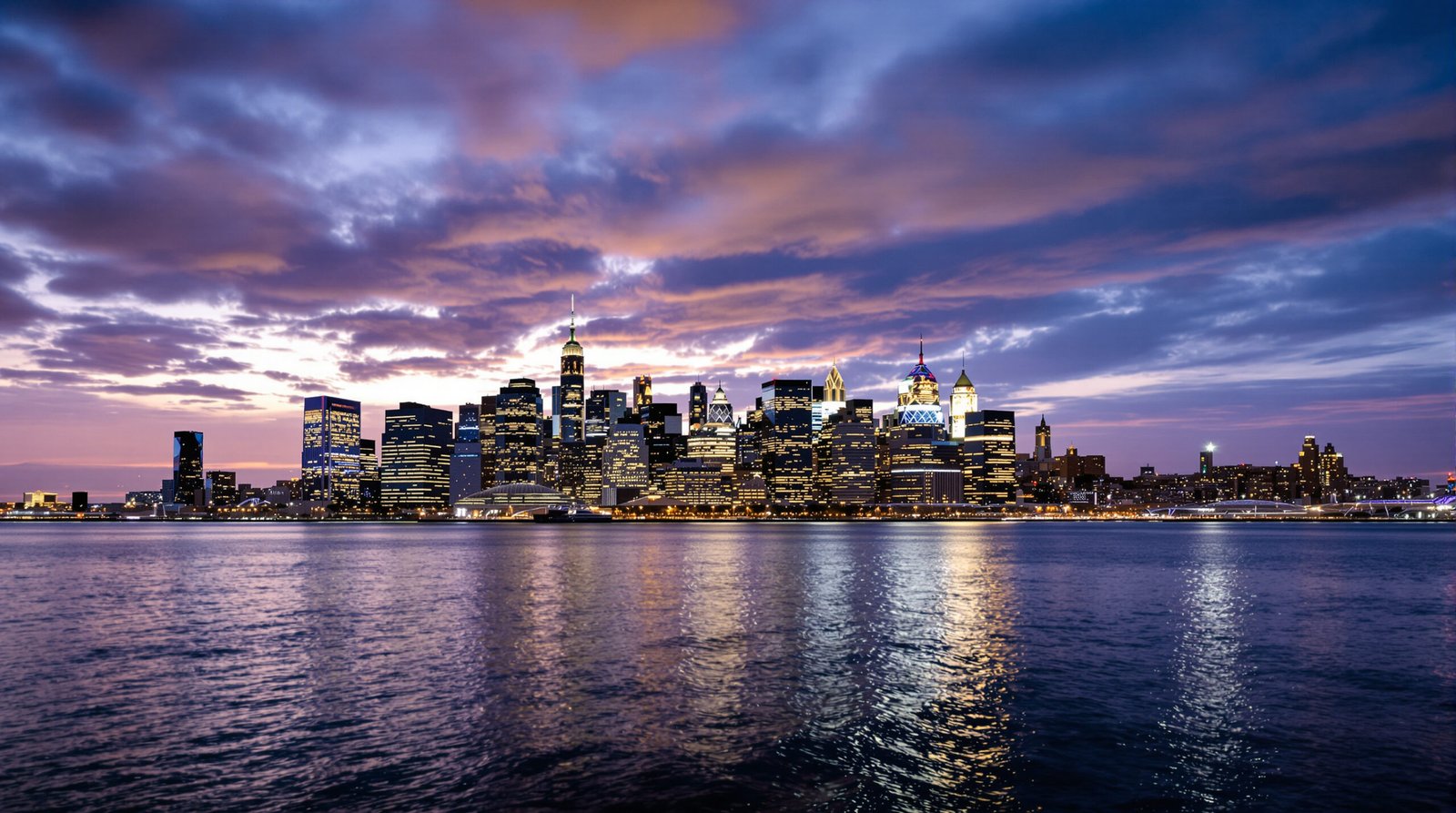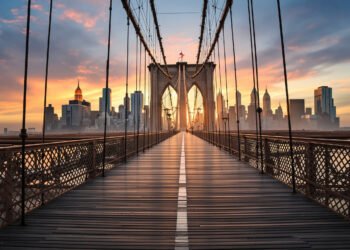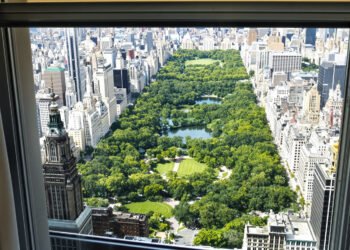Key Takeaways
- Best Time to Visit: Discover why spring (April-June) and fall (September-November) offer the most pleasant weather for exploring the city on foot.
- Top Attractions: Learn essential tips for visiting iconic landmarks like the Statue of Liberty, Empire State Building, and Central Park, including how to beat the crowds.
- Navigating the City: Master the NYC subway system like a local and understand the best ways to get around, from walking to ride-sharing.
- Culinary Delights: Uncover the must-try foods that define New York, from classic pizza slices and bagels to diverse international cuisine and trendy food halls.
- Budgeting & Saving: Get practical advice on how to experience the best of the Big Apple without breaking the bank, including free activities and money-saving hacks.
- Itinerary Ideas: Find a sample 3-to-5-day itinerary to help you structure your trip and make the most of your time in the city that never sleeps.
Introduction
Welcome to New York City, the concrete jungle where dreams are made. There’s a certain magic in the air here, an electric pulse that you can feel from the moment you arrive. It’s in the steam rising from a street vendor’s cart, the distant wail of a siren, the murmur of a dozen different languages on a single subway car, and the breathtaking moment the skyline reveals itself. This city is a living, breathing entity, constantly changing yet eternally familiar from its starring role in countless films and stories.
As a local, I’ve had the privilege of exploring its every corner, from the tourist-packed avenues of Midtown to the quiet, cobblestoned streets of the West Village. I’ve seen the city glitter under a blanket of fresh snow and sizzle in the summer heat. This guide is my love letter to New York, written to help you peel back its layers and discover the experiences that will stay with you long after you’ve left. Forget the clichés; we’re going to find the real New York together.
This isn’t just a checklist of places to see. It’s an invitation to wander, to get a little lost, and to find your own rhythm in the city’s chaotic symphony. Whether you’re here for the world-class museums, the dazzling Broadway shows, the unparalleled food scene, or simply to soak in the atmosphere, this New York travel guide will give you the tools to craft an unforgettable adventure.
Planning Your New York Trip
Timing is everything when it comes to planning a trip to New York. The city experiences four distinct seasons, each offering a unique vibe. Spring (April to June) and fall (September to November) are arguably the best times to visit. The weather is mild and pleasant, perfect for long walks through Central Park or across the Brooklyn Bridge. The city is alive with blooming flowers in spring and vibrant foliage in autumn, providing a stunning backdrop for your photos.
Summer (July and August) can be hot and humid, but it’s also the season of outdoor concerts, rooftop parties, and a lively, energetic atmosphere. If you don’t mind the heat, it’s a fantastic time to experience the city’s vibrant outdoor culture. Winter (December to February), on the other hand, brings a magical, festive spirit. The holiday decorations, ice skating at Rockefeller Center, and the chance of a snowy day make it a truly special, albeit cold, time to be here.
Regardless of when you decide to visit, booking your key arrangements in advance is crucial. This includes flights, accommodation, and any must-see Broadway shows or popular tours. New York is a perennially popular destination, and prices can skyrocket for last-minute bookings. Planning ahead not only saves you money but also ensures you don’t miss out on experiences that have limited availability.
Getting to New York
New York City is served by three major airports: John F. Kennedy International Airport (JFK), LaGuardia Airport (LGA), and Newark Liberty International Airport (EWR) in neighboring New Jersey. JFK is the primary international gateway, while LaGuardia mostly handles domestic flights. Newark serves both domestic and international routes and is often a convenient option, especially if you’re staying on the west side of Manhattan.
From any of these airports, you have several options to get into the city. Taxis and ride-sharing services like Uber and Lyft are readily available but can be expensive, especially during peak traffic. For a more budget-friendly option from JFK, you can take the AirTrain to the subway system. From Newark, the AirTrain connects to NJ Transit trains that run directly to Penn Station in Midtown Manhattan. LaGuardia is closest to the city, and while it lacks a direct rail link, the public bus service can connect you to the subway.
Finding the right flight is the first step to any great trip, and with so many options flying into the New York area, it pays to compare. A little research can help you find the best deals on flights, allowing you to save your budget for what really matters: experiencing the city itself. Consider flying mid-week or during the shoulder seasons for potentially lower fares.
Navigating the City
Once you’re in Manhattan, the best way to get around is the same way locals do: the subway. The NYC subway system is one of the oldest and most extensive in the world, running 24/7. It might seem intimidating at first, but with a good map app on your phone (like Google Maps or Citymapper), you’ll be navigating it like a pro in no time. You can pay per ride using the OMNY contactless payment system (just tap your credit card or phone) or buy a MetroCard.
Walking is another essential New York experience. The city is built on a grid system, making it surprisingly easy to navigate on foot. Walking allows you to discover hidden gems, stumble upon charming cafes, and truly feel the energy of the different neighborhoods. For longer distances above ground, the city’s bus network is extensive and offers a more scenic, albeit slower, alternative to the subway.
Yellow cabs are iconic, and you should hail one at least once for the experience. Ride-sharing apps are also ubiquitous. While you can rent a car, it’s generally not recommended for tourists staying within the five boroughs. Traffic is intense, parking is incredibly expensive and difficult to find, and the public transit system is far more efficient. However, if you’re planning day trips outside the city, arranging a car rental for a day or two can be a great way to explore the wider region.
Statue of Liberty & Ellis Island
No trip to New York is complete without paying a visit to Lady Liberty. A powerful symbol of freedom and hope, the Statue of Liberty is a breathtaking sight to behold up close. The ferry ride to Liberty Island offers spectacular views of the Manhattan skyline, and once there, you can walk around the base of the statue and visit the museum to learn about its history and construction.
Your ferry ticket also includes a stop at Ellis Island, the historic gateway for over 12 million immigrants to the United States. Walking through the Great Hall of the Ellis Island National Museum of Immigration is a profoundly moving experience. You can almost hear the echoes of the past as you explore the exhibits and search the passenger records for ancestors who may have passed through these very halls.
To visit, you must book your ferry tickets in advance through the official and only authorized vendor, Statue City Cruises. Be wary of street vendors selling tickets, as they are often overpriced or not valid. For access to the pedestal or the crown, you need to book several months in advance, as these tickets are extremely limited and sell out quickly.
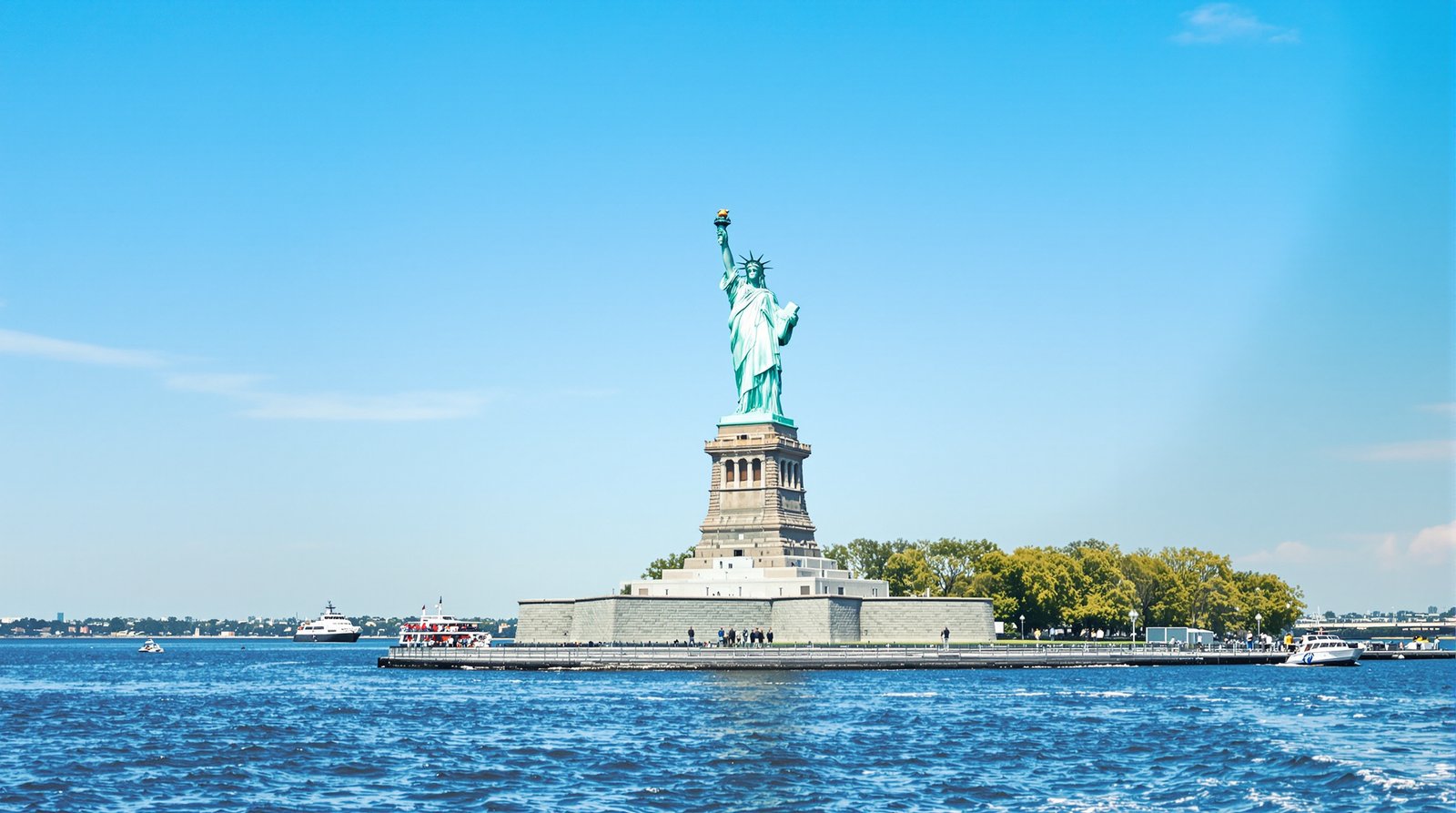
Times Square
Love it or hate it, Times Square is the dazzling, chaotic, and unapologetic heart of New York City. It’s a sensory overload in the best possible way, with towering digital billboards, costumed characters, and a constant river of people from every corner of the globe. There’s an undeniable energy here that is quintessentially New York, and experiencing it, even for a moment, is a must.
Beyond the spectacle, Times Square is the epicenter of the Theater District. The bright lights of Broadway marquees beckon, promising world-class performances and unforgettable nights out. It’s also a hub for major flagship stores, restaurants, and the famous red steps of the TKTS booth, where you can often snag discounted same-day theater tickets.
My advice for visiting Times Square is to go twice: once during the day to see the sheer scale of it all, and again at night when the billboards truly come to life and illuminate the sky. To get a great view without being swept away by the crowd, find a spot on the pedestrian plazas or climb the red steps. For information on events and what’s happening, the official Times Square website is a great resource for planning your visit.
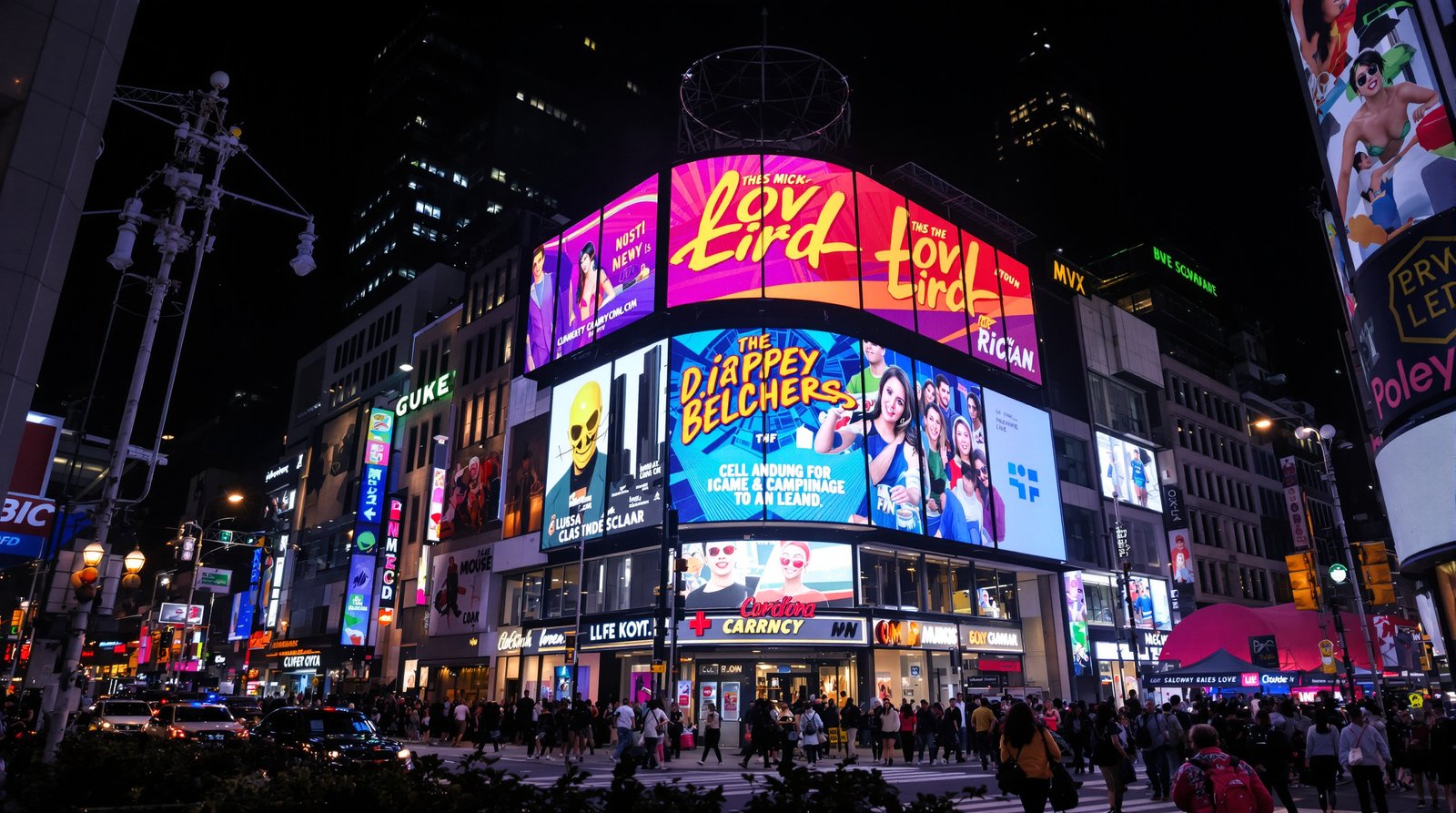
Central Park
Spanning 843 acres, Central Park is Manhattan’s magnificent green oasis and the backyard for millions of New Yorkers. It’s a masterpiece of landscape architecture, offering a diverse range of scenery, from manicured gardens and sprawling lawns to rugged woodlands and serene lakes. It’s the perfect place to escape the city’s relentless pace and reconnect with nature.
There is an endless list of things to do within the park. You can rent a rowboat on The Lake with the iconic Bow Bridge in the background, have a picnic on the Great Lawn, or pay your respects to John Lennon at Strawberry Fields. Don’t miss Bethesda Terrace and its beautiful fountain, one of the park’s most iconic and photographed spots. For a bit of whimsy, seek out the Alice in Wonderland and Hans Christian Andersen statues.
One of the best ways to explore Central Park is simply to wander without a plan, but if you prefer some structure, there are countless walking and biking paths to follow. You can rent a bike or simply stroll along the main loop. For a deeper dive into the park’s history, design, and hidden corners, the Central Park Conservancy offers guided tours and a wealth of information to help you make the most of your visit.
Empire State Building
An enduring icon of the New York skyline, the Empire State Building is more than just a skyscraper; it’s a piece of history. From its Art Deco lobby to its world-famous observation decks, a visit here feels like stepping back in time. The building has captured the world’s imagination for decades, and the experience of ascending to its heights lives up to the hype.
The main observation deck on the 86th floor is open-air, offering 360-degree views of the city. On a clear day, you can see for miles, spotting landmarks like the Chrysler Building, Central Park, and the Statue of Liberty. For an even more exclusive experience, you can purchase a ticket to the top deck on the 102nd floor, a climate-controlled viewing area with floor-to-ceiling windows.
To make your visit special, consider going during sunset. Watching the sky change colors and the city lights begin to twinkle below is a truly magical experience. Be sure to book your tickets online in advance at the official Empire State Building website to choose your time slot and avoid the longest lines. The interactive museum on the 2nd and 80th floors is also worth exploring to learn about the building’s incredible construction and cultural impact.

Brooklyn Bridge & DUMBO
Walking across the Brooklyn Bridge is a quintessential New York experience that should be on every visitor’s list. This architectural marvel, completed in 1883, connects Manhattan and Brooklyn and offers some of the most breathtaking views of the city. The dedicated pedestrian walkway is elevated above the traffic, providing an uninterrupted panorama of the Lower Manhattan skyline, the Statue of Liberty, and the East River.
For the best experience, start your walk from the Brooklyn side and head towards Manhattan. This way, you’ll be facing the iconic skyline for the entire journey. The walk itself takes about 30-60 minutes, depending on your pace and how often you stop for photos (which will be often). Try to go early in the morning to avoid the biggest crowds and enjoy the soft morning light.
Before or after your walk, spend some time exploring the DUMBO neighborhood on the Brooklyn side. Its name stands for Down Under the Manhattan Bridge Overpass, and its cobblestone streets and converted warehouses are now home to trendy boutiques, art galleries, and fantastic eateries. Don’t miss the iconic photo spot on Washington Street, where the Manhattan Bridge perfectly frames the Empire State Building.
Museums of New York
New York is a cultural powerhouse, and its museums are among the best in the world. Whether you’re an art aficionado, a history buff, or a science enthusiast, there’s a museum here for you. The most famous cluster is along Fifth Avenue’s Museum Mile, but incredible institutions are scattered throughout the city.
The Metropolitan Museum of Art, or The Met, is an absolute must-visit. Its collection is so vast that you could spend days here and still not see everything. From the Egyptian Temple of Dendur to masterpieces by Vermeer and Van Gogh, the breadth of human creativity on display is staggering. Plan to spend at least a few hours here, and pick a few wings that interest you most to avoid feeling overwhelmed.
For lovers of modern and contemporary art, the Museum of Modern Art (MoMA) is essential. It houses iconic works like Van Gogh’s “The Starry Night” and Picasso’s “Les Demoiselles d’Avignon.” Meanwhile, the American Museum of Natural History is a paradise for families and anyone fascinated by the natural world, with its famous dinosaur halls and the stunning Milstein Hall of Ocean Life. To plan your visit to the city’s premier art institution, check out The Met’s official website.
Broadway & The Theater District
There is nothing quite like the magic of a Broadway show. The energy, the talent, and the spectacle create an experience that is unique to New York. The Theater District, centered around Times Square, is home to dozens of historic theaters showcasing everything from long-running blockbusters like “The Lion King” and “Wicked” to the latest critically acclaimed plays and musicals.
Seeing a show is a quintessential part of any New York trip. The quality of the productions is unparalleled, featuring some of the best performers, writers, and designers in the world. Whether you’re laughing at a comedy, moved by a drama, or singing along to a musical, a night on Broadway is an unforgettable event.
Tickets can be expensive, but there are ways to find deals. The TKTS booth in Times Square offers same-day tickets for a variety of shows at discounts of 20-50%. You can also try digital lotteries or rush tickets, which are offered by many shows for a fraction of the price on the day of the performance. For a full listing of current shows and official ticket information, The Broadway League’s website is the most reliable source.
Hidden Gems in New York
While the iconic landmarks are a must-see, the true soul of New York is often found in its quieter corners and lesser-known spots. To experience the city like a local, venture off the beaten path and explore some of its hidden gems. The West Village, with its leafy, winding streets and historic brownstones, feels a world away from the grid of Midtown. It’s the perfect place for a leisurely stroll, with charming boutiques and cozy cafes at every turn.
For a unique park experience, head to the High Line. This elevated park was built on a defunct freight rail line and winds its way along the west side of Manhattan. It offers a fascinating perspective on the city, with art installations, gardens, and views of the Hudson River. It’s a beautiful example of urban renewal and a favorite spot for both locals and visitors.
Other hidden treasures include the Morgan Library & Museum, a stunningly preserved library from the Gilded Age; Roosevelt Island, accessible by a scenic tramway that offers incredible skyline views; and the speakeasy-style bars hidden behind unassuming storefronts. Don’t be afraid to wander into a neighborhood you haven’t heard of—you might just find your new favorite spot in the city.
New York Food & Culinary Experiences
New York is one of the greatest food cities in the world, a melting pot of cultures where you can find just about any cuisine imaginable. The city’s culinary identity is defined by a few iconic dishes that you simply have to try. First and foremost is the New York-style pizza, sold by the slice in countless pizzerias. It’s thin, foldable, and utterly delicious. Then there are the bagels, which are a breakfast institution—best served toasted with cream cheese and lox.
Don’t underestimate the humble street cart. A classic New York hot dog with all the fixings or a plate of chicken and rice from a halal cart are essential, budget-friendly culinary experiences. And for dessert, you can’t leave without trying a slice of rich, dense New York cheesecake. These are the flavors that form the city’s gastronomic foundation.
Beyond the classics, the city’s food scene is incredibly diverse. You can find authentic dim sum in Chinatown, incredible pasta in the West Village, and Michelin-starred tasting menus in Tribeca. Food halls like Chelsea Market and Smorgasburg (in Brooklyn) are fantastic places to sample a wide variety of dishes from local vendors. With so many options, choosing where to eat can be as important as choosing where to stay, and finding the right neighborhood is key. After a long day of culinary exploration, having a comfortable place to rest is essential, so be sure to find a hotel that puts you in the heart of the action.

Best Food Tours & Local Experiences
With such an overwhelming number of food options, one of the best ways to dive into the local culinary scene is by taking a food tour. These guided walks not only introduce you to the best bites but also provide a rich historical and cultural context for the neighborhoods you’re exploring. A food tour of Greenwich Village, for example, might combine pizza and cannoli tastings with stories of the neighborhood’s bohemian past.
These tours are led by passionate locals who can take you to hidden gems you’d never find on your own. They know the family-run delis that have been serving pastrami for generations, the bakeries with the best cannoli, and the pizzerias that locals swear by. It’s a fantastic way to sample a lot of different things without having to commit to a full meal at each place.
Beyond formal tours, you can create your own culinary adventure by visiting one of the city’s many markets. The Union Square Greenmarket is a vibrant farmers market where you can see what’s in season and sample local products. For a more curated experience, food halls like the Essex Market on the Lower East Side offer a mix of classic vendors and modern eateries. To discover and book a wide range of these experiences, from food tours to cooking classes, you can explore the many tours available and find the perfect one to satisfy your appetite.
New York by Night
When the sun goes down, New York transforms into a different city, one that glitters with possibility. The nightlife here is as diverse as its population, offering something for every mood and taste. For breathtaking views, head to one of the city’s many rooftop bars. Sipping a cocktail while looking out at the illuminated skyline is an experience you won’t soon forget. Brooklyn, particularly Williamsburg and DUMBO, offers some of the best rooftop views of the Manhattan skyline.
For live music lovers, the city is a playground. Greenwich Village and the East Village are packed with legendary music venues where you can catch everything from jazz and blues to indie rock and folk. Comedy clubs are another New York institution, with famous spots like the Comedy Cellar showcasing both established stars and up-and-coming talent.
Even if you’re not looking for a party, the city is magical to explore at night. A stroll through a quieter neighborhood like the West Village, with its gas-lit lamps and charming streets, can be incredibly romantic. Seeing landmarks like the Brooklyn Bridge or Grand Central Terminal lit up at night offers a completely different perspective. The city that never sleeps is always ready to entertain, inspire, or simply dazzle you.
Parks & Outdoor Spaces
While Central Park gets most of the attention, New York is filled with fantastic parks and green spaces that offer a welcome respite from the urban hustle. The High Line, an elevated park built on a former railway on the west side, is a must-visit. This linear park offers a unique journey through different neighborhoods, with curated gardens, public art, and stunning views of the city and the Hudson River.
Bryant Park, located just behind the New York Public Library in Midtown, is a small but vibrant hub of activity. In the summer, it hosts free movie nights, concerts, and outdoor classes. In the winter, it transforms into a magical Winter Village with an ice-skating rink and holiday shops. It’s a perfect example of a small urban space making a huge impact.
For those willing to venture beyond Manhattan, Brooklyn’s Prospect Park is a sprawling masterpiece designed by the same architects as Central Park. It has a more relaxed, local feel and features a beautiful lake, a zoo, and the Brooklyn Botanic Garden next door. These green spaces are the city’s lungs, essential for a moment of peace and a different perspective on urban life.

Day Trips from New York
If you have an extended stay in New York, taking a day trip can be a fantastic way to see more of the region. The extensive rail and bus network makes it easy to explore nearby cities and attractions without needing a car. Philadelphia, the birthplace of the United States, is just a 90-minute train ride away. You can easily spend a day exploring Independence Hall, the Liberty Bell, and the city’s rich history before heading back to NYC.
For a taste of the coast, the Hamptons on Long Island offer beautiful beaches, charming towns, and a glimpse into the lives of New York’s elite. While it’s a popular summer destination, it’s lovely in the shoulder seasons as well. Closer to the city, towns along the Hudson River like Cold Spring or Beacon offer hiking, antiquing, and a quaint, small-town feel.
For a truly epic excursion, you can even take a trip to see the magnificent Niagara Falls. While it’s a long journey for a single day, several tour operators offer packages that include flights or comfortable buses, making it a feasible, albeit long, day trip. These excursions provide a wonderful contrast to the urban environment of New York City and showcase the diversity of the region. You can find many organized day trips from NYC that handle all the logistics for you.
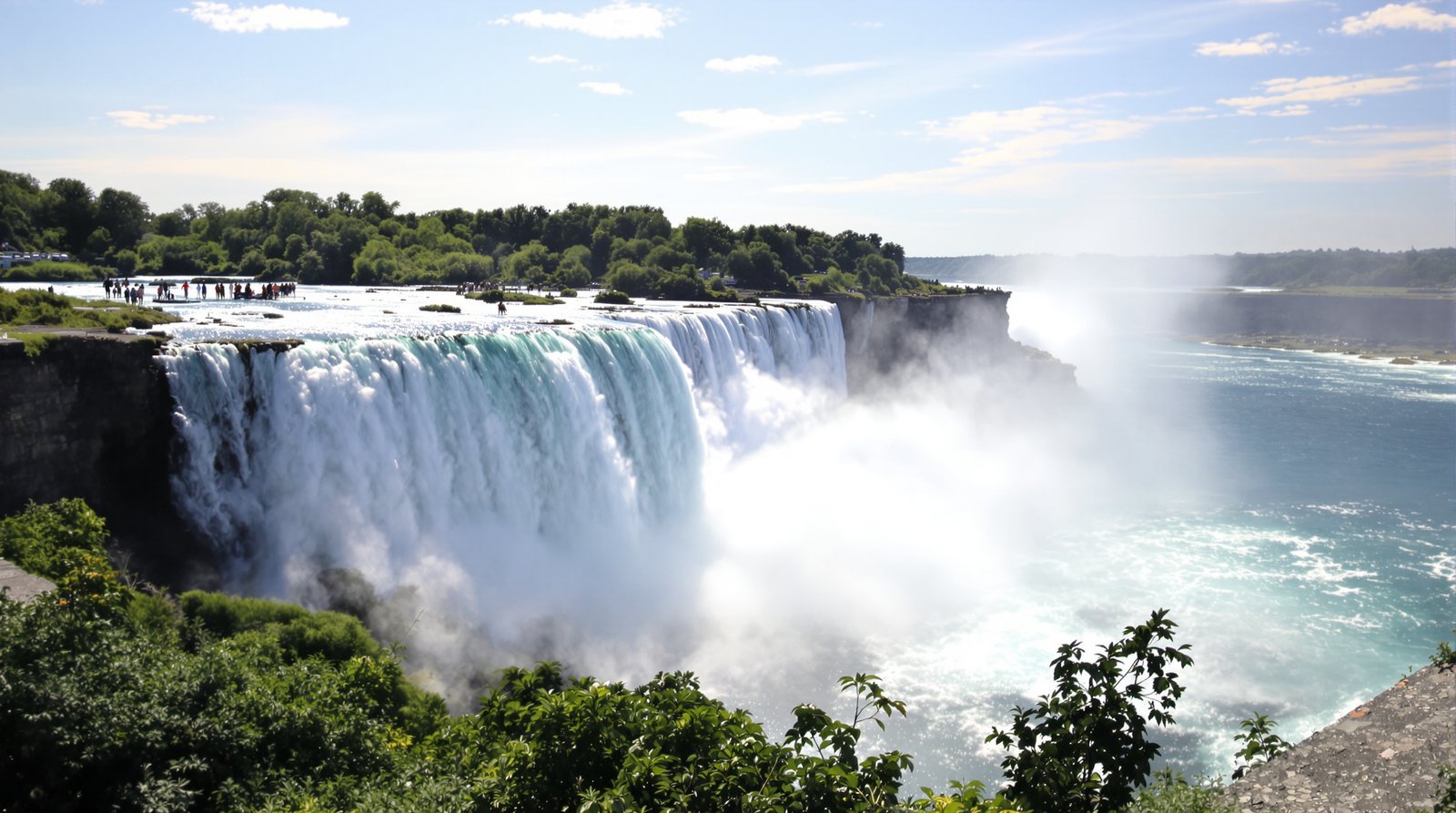
Practical Tips for Visitors
To make your New York trip as smooth as possible, a few practical tips can go a long way. First, wear comfortable shoes. You will be doing a lot of walking, and nothing ruins a day of exploring faster than sore feet. Second, always be aware of your surroundings. New York is generally a safe city for tourists, but like any major metropolis, it’s wise to keep an eye on your belongings, especially in crowded areas and on the subway.
Tipping is a crucial part of the culture in the United States. In restaurants, a tip of 15-20% of the pre-tax bill is standard for good service. You should also tip bartenders ($1-2 per drink), taxi drivers (15-20%), and hotel staff. It’s an important part of the workers’ income, so be sure to factor it into your budget.
When it comes to money, while credit cards are widely accepted, it’s always a good idea to have some cash on hand for small purchases, street vendors, or tips. If you’re visiting from abroad, avoid exchanging currency at the airport, where rates are typically poor. Using a service that offers better rates can save you a significant amount of money. For a smart and cost-effective way to handle your finances, consider using a modern currency exchange service that minimizes hidden fees.
Travel Insurance & Booking Essentials
One of the most important things to arrange before your trip is travel insurance. This is especially true when visiting the United States, where healthcare costs are notoriously high. An unexpected illness or accident could result in astronomical medical bills, and having comprehensive insurance provides peace of mind and financial protection. It’s a small investment that can save you from a potential disaster.
When looking for a policy, make sure it covers medical emergencies, trip cancellations, and lost or stolen luggage. There are many providers to choose from, so it’s worth shopping around to find a plan that fits your needs and budget. For international visitors, securing reliable travel insurance is not just a recommendation; it’s an absolute necessity for a worry-free trip.
In addition to insurance, remember to book popular attractions and tours in advance, especially during peak season. Tickets for places like the Statue of Liberty crown, top Broadway shows, and special museum exhibits can sell out weeks or even months ahead. Booking ahead not only guarantees your spot but can also help you skip long lines, saving you precious time to enjoy the city.
Sample Itinerary: 3 to 5 Days in New York
To help you structure your trip, here’s a sample itinerary that covers many of the city’s highlights. Feel free to mix and match based on your interests.
Day 1: Midtown Marvels
- Morning: Arrive and check into your hotel. Head to Times Square to soak in the energy, then walk to Bryant Park and the New York Public Library.
- Afternoon: Ascend the Empire State Building for panoramic views. Explore Grand Central Terminal’s stunning architecture.
- Evening: Enjoy a pre-theater dinner in the Theater District and catch a dazzling Broadway show.
Day 2: Downtown History & Brooklyn Views
- Morning: Take the first ferry to the Statue of Liberty and Ellis Island. Book tickets well in advance.
- Afternoon: Explore the Financial District, including Wall Street’s Charging Bull and the 9/11 Memorial & Museum.
- Evening: Walk across the Brooklyn Bridge from Brooklyn to Manhattan at sunset. Grab a pizza dinner in DUMBO or Brooklyn Heights.
Day 3: Art, Culture & Green Space
- Morning: Spend the morning at the Metropolitan Museum of Art on Museum Mile.
- Afternoon: Stroll or rent a bike in Central Park. Visit Strawberry Fields, Bethesda Fountain, and The Mall.
- Evening: Explore the charming streets and cozy restaurants of the West Village.
If you have 5 days:
- Day 4: Explore more neighborhoods. Wander through SoHo for shopping, Greenwich Village for its bohemian vibe, and the East Village for its edgy history and great food.
- Day 5: Choose your own adventure. Visit another museum like MoMA or the Natural History Museum, walk the High Line, or take a food tour of a neighborhood like Chinatown or Little Italy.
Conclusion
New York City is more than just a destination; it’s an experience. It’s a city that challenges you, inspires you, and ultimately, captivates you. From the soaring heights of its skyscrapers to the intimate charm of its neighborhood streets, there is a story waiting to be discovered around every corner. The energy of 8 million people chasing their dreams is palpable, creating a symphony of ambition, creativity, and resilience that is utterly unique.
Whether you come for the art, the food, the history, or the simple thrill of being in the center of the universe, New York delivers. It’s a city that is constantly reinventing itself, meaning that no two visits are ever the same. There is always a new restaurant to try, a new gallery to explore, a new neighborhood to fall in love with. The magic of New York is that it belongs to everyone who comes here, ready to embrace its beautiful, chaotic spirit.
Now is the perfect time to stop dreaming and start planning. The city is waiting for you with open arms, ready to share its secrets and create memories that will last a lifetime. When you’re ready to turn your New York dream into a reality, let us help you build the perfect itinerary with our smart booking tools.
FAQs
1. What’s the best time of year to visit NYC?
Spring (April-June) and fall (September-November) are ideal, with pleasant weather perfect for walking. However, the holiday season in December is magical, and summer offers vibrant outdoor events.
2. How many days do I need in New York?
A minimum of 3-4 days is recommended to see the main highlights. However, 5-7 days will allow you to explore different neighborhoods and experience the city at a more relaxed pace.
3. Is New York City safe for tourists?
Yes, New York is generally very safe for tourists, especially in the main tourist areas. Like any large city, it’s important to be aware of your surroundings, avoid walking alone in deserted areas late at night, and keep your valuables secure.
4. How do I get around the city?
The subway is the most efficient and affordable way to travel long distances. For shorter trips, walking is often best. Yellow cabs and ride-sharing apps are also readily available.
5. Is New York expensive? How can I save money?
New York can be expensive, but there are many ways to save. Eat at slice shops and food carts, take advantage of free attractions like walking the Brooklyn Bridge and exploring Central Park, and look for free museum admission days. The Staten Island Ferry is also free and offers great views of the Statue of Liberty.
6. What should I pack for a trip to New York?
Comfortable walking shoes are non-negotiable. Pack layers, as the weather can change throughout the day. In winter, you’ll need a warm coat, hat, and gloves. In summer, light clothing is best, but always have a sweater or light jacket for air-conditioned interiors.
7. Do I need to tip in New York?
Yes, tipping is customary and expected. Plan to tip 15-20% at restaurants, $1-2 per drink for bartenders, and 15-20% for taxi drivers. It’s an important part of the service industry’s wages.



